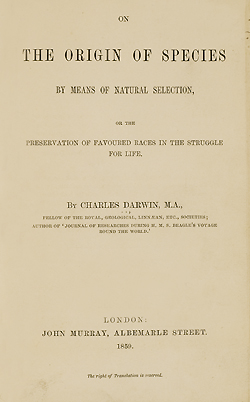The Books of Darwin
Writing the Origin

Charles Darwin, On the origin of species, 1859
Before putting his theory out to the scrutiny of his colleagues, Darwin knew that his ideas needed to researched, shaped, and developed. He was busy: the Beagle voyage had provided enough material for several careers. Up to 1854, Darwin devoted himself to researching, editing, and publishing authoritative accounts of the narrative, zoology, and geology of the Beagle voyage, as well as on living and fossil barnacles, an interest that emerged from those efforts. This remarkable body of work established his reputation as an accomplished and learned naturalist. Only in September 1854 did Darwin begin sustained work on developing and writing up his “transmutation” ideas; by the summer of 1858 he had to hand ten substantial chapters of a planned book on natural selection.
Just at this time, in June 1858, a letter arrived from Alfred Russel Wallace (1823-1913), a naturalist working in East Asia, with a manuscript laying out a theory much like Darwin’s. Amid consternation that he would lose priority and credit for his ideas, Darwin consulted with his scientific friends, who arranged that extracts both from Wallace’s manuscript and from Darwin’s unpublished work would both be read to the Linnean Society in London, on July 1. After these papers— publication in the society’s Proceedings, Darwin set himself to putting out his theory as a book. He reworked a third of his manuscript and prepared an equal amount of new material. On October 1, 1859, fifteen months after his first public statement, Darwin finished proofing the new work, which he considered but an “Abstract,” though one that weighed in at over 500 pages. When On the Origin of Species by Means of Natural Selection appeared on November 24, it completely sold out. Six editions appeared in Darwin’s lifetime; the book has been continuously in print for 150 years.
The book, Darwin noted, was one long argument, starting with its introductory chapter that stated the basic theory: any variation among individuals, any new trait, if it provided some adaptive advantage, would be selected by the great hand of nature, the “struggle for existence.” Through inheritance, traits would be passed to descendents, and, over time, selected traits would be established in increasingly more individuals. In this way, the “typical” form would change, and a new species emerge. This was the origin of species by means of natural selection: Darwin’s purpose in the Origin was to show the plausibility of his argument.
Last Reviewed: January 25, 2024


